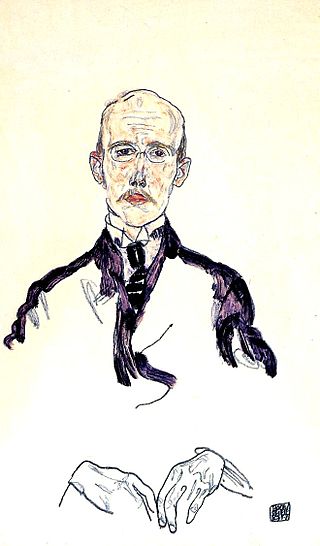Robert Hudson Tannahill was a Detroit art collector and benefactor.

Justin K. Thannhauser (1892–1976) was a German art dealer and collector who was an important figure in the development and dissemination of modern art in Europe.

Karl Mayländer was an Austrian art collector and businessman who was deported in 1941 from Vienna to Łódź, in German-occupied Poland, by the Nazis and later murdered in the Shoah.

The Diggers or Two Diggers is an oil painting by Dutch artist Vincent van Gogh painted in late 1889 in Saint-Rémy-de-Provence, France. It is in the Detroit Institute of Arts (DIA), Detroit, Michigan, United States. The Diggers is sometimes called Two Diggers among Trees to distinguish it from The Diggers , 1889.
Fritz Nathan was a German-Swiss gallery owner and art dealer.

Many priceless artworks by the Dutch Post-Impressionist artist Vincent van Gogh were looted by Nazis during 1933–1945, mostly from Jewish collectors forced into exile or murdered.
Rosa Oppenheimer was a German Jewish art dealer who was murdered in the Holocaust. The art she owned together with her husband Jacob is the subject of several high-profile restitution claims.

The art collection of Ismar Littmann (1878–1934), a German lawyer who lived in Breslau, comprised 347 paintings and watercolors and 5,814 drawings from artists such as Lovis Corinth, Max Pechstein, Erich Heckel, Max Liebermann, Käthe Kollwitz, Lucien Adrion, and Otto Mueller.
Max Silberberg was a major cultural figure in Breslau, a German Jewish entrepreneur, art collector and patron who was robbed and murdered by the Nazis. His art collection, among the finest of its era, has been the object of numerous restitution claims.

Paul Robert Ernst von Mendelssohn-Bartholdy was a German Jewish banker and art collector. The persecution of his family under the Nazis has resulted in numerous lawsuits for restitution.
Alexander Vömel, or Voemel, was a German gallery owner and Nazi party member who took over the gallery of the Jewish art dealer Alfred Flechtheim when it was Aryanized in 1933.
Johanna Margarethe Stern-Lippmann was a German Jewish art collector and victim of the Holocaust.
Oscar Reichel was an Austrian physician and art collector. His work was confiscated by the Nazis during World War II, leading to claims from his descendants to restore it to them.
Daisy Hellmann (1890-1977) was a Viennese art patron and collector persecuted by the Nazis because of her Jewish ancestry.
Ernst Flersheim was a German Jewish art collector who was persecuted by the Nazis.
Otto Nathan Deutsch was a Jewish art collector and refugee from Nazis.
Hedwig Frida Ullmann, née Nathan, was a German Jewish art collector and refugee.
Robert Graetz, was a German Jewish textile industrialist and art collector in Berlin who was deported by the Nazis and died at Auschwitz.
Le Moulin de la Galette is an oil painting on canvas created in 1900 by Pablo Picasso, and currently owned by the Guggenheim Museum in New York.







